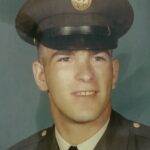2022 Honoree
U.S. Army, Army Reserves
Vietnam, Desert Storm
When 19-year-old John Harry Trease left for the Vietnam War in 1968, his father gave him two silver quarters with the advice if he kept them, he would never be broke. When required to surrender all U.S. currency, Trease kept those quarters tucked away in his pocket. When he came home, he shared with his parents: “No matter where I was, no matter what was going on, I could reach in my pocket, rub those quarters together and it would bring me home to this kitchen,” he recalled. “It was the greatest feeling I’ve ever had.”
On the flight into Vietnam, Trease’s plane was diverted to the Philippines due to the attack on the Saigon Airport. When they finally landed, he dropped his gear on his bunk and headed out for KP duty only to face early the next morning that his barracks were completely destroyed. With no gear, he was hustled to his assigned unit where during orientation, a fire barrage hit the camp and his hooch was flattened. Two days, two attacks … he began questioning what he’d gotten into.
Trained as a mortar man, Trease was assigned to mechanized infantry; he volunteered to be a forward observer. “The life expectancy of a forward observer was about 15 minutes,” he said. “I made it eight months.” During five weeks of continual enemy fire, two of which were road security, the convoy’s front tank took a direct hit, blowing the driver off the track and wounding the gunner. Trease scrambled over the side of his carrier, grabbed the gunner, passed him up the line and watched as the convoy took off without him. Weaponless, he was still wearing his radio, and directed a successful fire mission.
On a routine patrol a few months later, Trease’s crew was sitting on the back of their M113 Armored Personnel Carrier, when it was hit by 60mm mortar rounds wounding all six men. Trease placed a compression bandage on one wounded soldier’s neck and carried him up the roadside berm, stepped on a second soldier and after falling down, managed to drag all three of them up the hill, into the hands of a medic. Trease returned to his gun ship, manned his radio, coordinated firepower and air support while firing off a barrage of illumination and artillery rounds, until rescue arrived.
Trease joined the Army Reserves learning to fly helicopters with a 321st Medical Detachment. During Desert Storm, the medevac unit was attached to the 2nd Armored Cavalry Regiment. To conserve fuel the helicopters “fly to the front of the convoy, land, shut down and wait for them to catch up,” he said. “Then do it all again.” Trease’s silver quarters became known as his lucky pieces among his fellow soldiers which started a tradition of giving a silver coin to friends and loved ones upon deployment. Now, complete strangers relate the story back to him. Trease retired as Chief Warrant Officer 4 just shy of 41 years (40y 11m) with the Army / Army Reserves.

